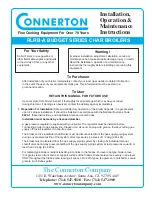
Infinity REU-2425W
- 23 -
Issue 2 - 5/07/04 ©Rinnai
15. Operation Principles
The preset temperature is selected at one of the remote controls (where fitted). Where no remote
control is fitted, the default temperature (Heavy Duty only) depending on the position of dip switch
numbers 4 to 8 (see page 14).
When the unit is first plugged into 240 Volts, the PCB assumes an incoming water temperature
of 25°C, this prevents the appliance starting on HIGH, and producing very hot water the first time
it is used.
The data used to determine the outgoing water temperature initially is incoming water flow, and
the remote control pre-set temperature.
From the incoming water flow and remote control pre-set temperature data, the CPU is able to
determine a suitable gas rate to kick the appliance off, once a hot water tap opens.
This calculation of temperature rise and water flow is called simulation feed-forward.
The water heater calculates incoming water temperature by subtracting the theoretical
temperature rise from the outgoing hot water temperature, to establish the correct gas flow.
When a hot water tap is opened, water begins to flow through the appliance. The turbine in the
water flow sensor begins to revolve. The revolution speed is proportional to the water flow. A
sensor located inside the device relays information in the form of magnetic pulses to the main
PCB to determine whether or not water is flowing, and also, the volume of water flowing. When a
pre-determined water flow is sensed, the ignition sequence begins.
The combustion fan pre-purges the combustion chamber. A rev counter on the combustion fan
indicates the fan rpm to the main PCB. Once the pre-purge cycle is completed, the PCB controls
the fan rpm by varying the DC voltage to the fan motor. This maintains the correct air/gas ratio
throughout the time the water heater is in use, to ensure good combustion.
The gas is ignited by direct electronic spark and the flame is sensed by the flame rod. The
opening degree of the modulating valve is determined by the combustion fan speed.
The changeover valve directs gas to one side or both sides of the burner. At the point where the
changeover valve opens or closes, the modulating valve is instantly re-adjusted by the PCB to
compensate for the change in the number of burners in use. From the information provided by the
water flow sensor and the water temperature thermistor, the PCB determines how much gas is
required to heat the water to the temperature selected on the remote control.
The PCB is programmed to provide the maximum volume of water possible at a given
temperature rise. As the water flow from the tap is increased, the PCB increases the gas and air
flow to the burner.
Once the maximum gas rate is reached the PCB begins to control the water flow through the
appliance in order to maintain the preset temperature. This is achieved by the PCB turning the
valve within the water flow control device by means of a stepping motor.
The water flow control device operates at high water flows and/or high temperature rises. When
the temperature rise is low, or the water flow is restricted by the hot water tap, then the device
may not be required to operate. [See section on “Main Components” on page 18, for clarification].
Summary of Contents for REU-2018W
Page 8: ...Infinity REU 2425W 5 Issue 2 5 07 04 Rinnai 3 Dimensions Note All dimensions are in mm ...
Page 14: ...Infinity REU 2425W 11 Issue 2 5 07 04 Rinnai 7 Cut away Diagram ...
Page 15: ...Infinity REU 2425W 12 Issue 2 5 07 04 Rinnai 8 Schematic Diagram ...
Page 33: ...Infinity REU 2425W 30 Issue 2 5 07 04 Rinnai 20 Wiring Diagram ...
Page 54: ...Infinity REU 2425W 51 Issue 2 5 07 04 Rinnai 26 Exploded Diagram ...
Page 55: ...Infinity REU 2425W 52 Issue 2 5 07 04 Rinnai ...
Page 56: ...Infinity REU 2425W 53 Issue 2 5 07 04 Rinnai ...
Page 57: ...Infinity REU 2425W 54 Issue 2 5 07 04 Rinnai ...
Page 60: ...Infinity REU 2425W Issue 1 5 07 04 Rinnai Notes ...
















































